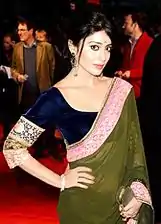The Hindi cinema portal

Hindi cinema, popularly known as Bollywood and formerly as Bombay cinema, refers to the film industry based in Mumbai, engaged in production of motion pictures in Hindi language. The popular term Bollywood is a portmanteau of "Bombay" (former name of Mumbai) and "Hollywood". The industry is a part of the larger Indian cinema, which also includes South Indian cinema and other smaller film industries.
In 2017, Indian cinema produced 1,986 feature films, of which the largest number, 364 have been in Hindi. , Hindi cinema represented 43 percent of Indian net box-office revenue; Tamil and Telugu cinema represented 36 percent, and the remaining regional cinema constituted 21 percent. Hindi cinema is one of the largest centres for film production in the world. Hindi films sold an estimated 341 million tickets in India in 2019. Earlier Hindi films tended to use vernacular Hindustani, mutually intelligible by speakers of either Hindi or Urdu, while modern Hindi productions increasingly incorporate elements of Hinglish.
The most popular commercial genre in Hindi cinema since the 1970s has been the masala film, which freely mixes different genres including action, comedy, romance, drama and melodrama along with musical numbers. Masala films generally fall under the musical film genre, of which Indian cinema has been the largest producer since the 1960s when it exceeded the American film industry's total musical output after musical films declined in the West. Dadasaheb Phalke's silent film Raja Harishchandra (1913) is the first feature length film made in India. The first Indian musical talkie was Alam Ara (1931), four years after the first Hollywood sound film The Jazz Singer (1927).
Alongside commercial masala films, a distinctive genre of art films known as parallel cinema has also existed, presenting realistic content and avoidance of musical numbers. In more recent years, the distinction between commercial masala and parallel cinema has been gradually blurring, with an increasing number of mainstream films adopting the conventions which were once strictly associated with parallel cinema. (Full article...)
Selected article
Dhoom 2 is a 2006 Bollywood action film directed by Sanjay Gadhvi and produced by Aditya Chopra and Yash Chopra at an estimated budget of ₹35 crore (US$4.4 million). It is the second film in the Dhoom series. Abhishek Bachchan and Uday Chopra star in the film as buddy cops Jai Dixit and Ali, respectively. The duo attempt to capture Mr. A (Hrithik Roshan), a professional thief whose passion is to steal rare and valuable collectibles using high-technology gadgets. The film was shot primarily in India, Durban, and Rio de Janeiro, becoming the first major Hindi film to be shot in Brazil. The film premiered on 24 November 2006 in India, where it received the widest release in Indian cinema history, with over 1800 prints. Dhoom 2 was generally well received by both critics and audiences. It became the highest-grossing Indian film of 2006, and was the highest-grossing film of all time. It is the seventh highest-grossing Bollywood film in overseas markets. After grossing over ₹150 crore (US$19 million), the film was elevated to a "blockbuster" rating on Box Office India. It received an 80% approval rating among critics on Rotten Tomatoes. Critics praised Dhoom 2 for its exotic locales and elaborate action sequences.
Did you know...
- ... that in the 2008 Bollywood film Krazzy 4, actor Hrithik Roshan (pictured) performed an "item number" for the first time?
- ... that Kaash was the last Hindi film in which Kishore Kumar did playback singing?
- ... that the 1955 Hindi film Vachan marked composer Ravi's debut as a film music director?
Subcategories

Hindi cinema Bollywood-related lists Actors in Hindi cinema Bollywood film awards Bollywood film clans Bollywood in fiction Bollywood playback singers Bollywood-based movie channels Hindi film score composers Hindi film cinematographers Hindi film editors Hindi film soundtracks Film studios in Mumbai Films set in Bihar Films set in Chhattisgarh Films set in Delhi Films set in Haryana Films set in Himachal Pradesh Films set in Jammu and Kashmir Films set in Jharkhand Films set in Ladakh Films set in Madhya Pradesh Films set in Mumbai Films set in Rajasthan Films set in Uttar Pradesh Films set in Uttarakhand Films shot in Bihar Films shot in Delhi Films shot in Haryana Films shot in Himachal Pradesh Films shot in Jammu and Kashmir Films shot in Jharkhand Films shot in Ladakh Films shot in Madhya Pradesh Films shot in Mumbai Films shot in Rajasthan Films shot in Uttar Pradesh Films shot in Uttarakhand Hindi-language film directors Hindi-language films Hindi-language lyricists Hindi-language screenwriters Hindi film producers Songs written for Hindi-language films Urdu-language Indian films |
Selected biography

Selected image
.jpg.webp)
WikiProjects
- WikiProject Film
- Indian cinema task force
- WikiProject India
- WikiProject Indian television
What are WikiProjects?
Recognised content
Topics
Awards: Bollywood Movie Awards (defunct) • Filmfare Awards • Global Indian Film Awards (defunct) • International Indian Film Academy Awards • National Film Awards • Screen Awards • Star Guild Awards • Stardust Awards • Zee Cine Awards
Institutions Asian Academy of Film & Television • Central Board of Film Certification • Directorate of Film Festivals • Film and Television Institute of India • Film City • Fox Star Studios • National Film Development Corporation of India • Satyajit Ray Film and Television Institute
Lists: List of Bollywood films • Film clans • Highest-grossing films in overseas markets • Highest-grossing films
Things you can do

- Add
{{portal|Hindi cinema}}to the See also section of Bollywood film-related articles. - Tag the talk pages of Bollywood film related articles with the {{WikiProject Film|Indian-task-force=yes}} banner.
- Collaborate with other participants at Wikipedia:WikiProject Film/Indian cinema task force.
- Cleanup: A cleanup listing for this project is available.
- Rate the Unassessed Bollywood articles in the Indian cinema task force.
- Cleanup needed
- Bot-generated cleanup listing • Hindi films and plagiarism • Ramoji Film City • IIFA Awards • IIFA • Anand Bakshi • Ajay Devgan • N. T. Rama Rao Jr.
- Requested articles
- List of missing Indian Films (see also lists of Indian films for redlinks) • Beary Cinema
- Expansion needed
- Draft articles: Tulu cinema • Anahat (film) • Prakash Jha • Central Board of Film Certification • Filmfare Awards South • Kerala Film Critics Association Awards • Amitabh Bachchan • Gabbar Singh • Sanjay Dutt • Hindustan Photo Films • Sanskrit cinema
- Citations needed
- Central Board of Film Certification
Related portals
Associated Wikimedia
The following Wikimedia Foundation sister projects provide more on this subject:
-
 Commons
Commons
Free media repository -
 Wikibooks
Wikibooks
Free textbooks and manuals -
 Wikidata
Wikidata
Free knowledge base -
 Wikinews
Wikinews
Free-content news -
 Wikiquote
Wikiquote
Collection of quotations -
 Wikisource
Wikisource
Free-content library -
 Wikiversity
Wikiversity
Free learning tools -
 Wiktionary
Wiktionary
Dictionary and thesaurus
More portals
-
 List of all portals
List of all portals -

-

-

-

-

-

-

-

-

-
 Random portal
Random portal -
 WikiProject Portals
WikiProject Portals
Shortcuts to this page: P:BOLLY